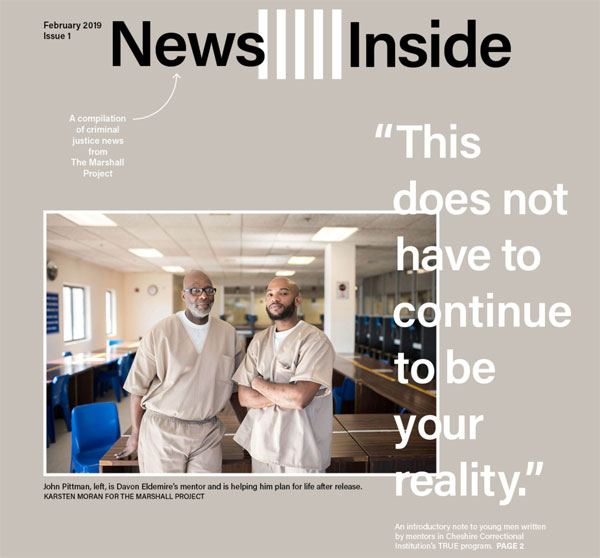
April 4, 2019; Colorlines
The Marshall Project is one of the more prominent of the nonprofit news sites with a deepened focus on a single topic—in this case, criminal justice. Others in its ilk are Inside Climate News and The Trace, which focuses on gun control. Each has its own flavor of coverage, with the Marshall Project taking a less advocacy-focused role by design. That may change a bit with the introduction of its newest endeavor.
The Marshall Project has launched News Inside, a periodical about incarcerated life in the United States, to be distributed to those who are currently in prison. Access to educational materials for incarcerated individuals has been an issue of historical and recent interest, whether it is access to actual collegiate style programs, or use of educational materials, such as books and magazines. The issue of mass incarceration makes this discussion even more timely, as the United States incarcerates more people than any other country, including counties such as China, that far exceed the US in terms of population.
News Inside was conceived by Lawrence Bartley, who himself spent 27 years incarcerated, finally winning parole in 2018. Bartley has stated that he wants to provide information to the incarcerated community, “particularly those who believe study is a chance for redemption, who sacrifice sleep and risk a misbehavior report to pore over textbooks under shaded lamps after lights-out, who struggle to find resources to expand their minds.” News Inside will provide criminal justice information, as well as content that “aims to inspire and empower people dealing with incarceration.”
Sign up for our free newsletters
Subscribe to NPQ's newsletters to have our top stories delivered directly to your inbox.
By signing up, you agree to our privacy policy and terms of use, and to receive messages from NPQ and our partners.
Currently, News Inside is in a pilot period, with the publication available in 30 facilities and 19 states. The Marshall Project is raising money to expand the reach of the publication to all 50 states. Bartley is acutely aware of the potential problems with making the publication available to sites across the country, as he notes that prison administrators could view it as “inflammatory” or likely to “stir unrest,” so he has chosen content with this potential obstacle in mind.
Given the Marshall Project’s self-imposed neutrality, the design of this new publication fits the larger standard, but its development will be interesting to watch. There is a principle in many prisons of “unit management”—that is, the smaller the unit, the more manageable it is. In this case, you can think of individuals as units. Thus, the built-in traditions of isolation prevail through such things as charging families outrageously for phone calls, the free and easy use of solitary, and arbitrary transfers. A mechanism meant to connect prisoners across different prisons, even if only through the written word, therefore, is a questionable endeavor to begin with. Keeping it unthreatening enough to stay approved will be a real tightrope act, and whether or not it can be made relevant within that constraint is anyone’s guess.—Kristen Munnelly and Ruth McCambridge
This article has been altered from its initial form. The call for “first-person essays from those who work or live in the criminal justice system” is for a different Marshall Project endeavor called Life Inside.













